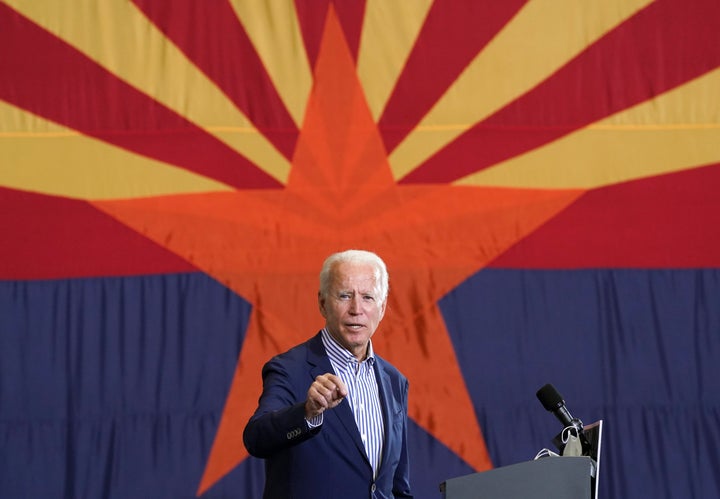
President-elect Joe Biden won the Nov. 3 election by flipping key battleground states to Democrats and trouncing President Donald Trump in the popular vote.
He likely couldn’t have pulled it off without Native American voters.
Arizona was a huge get for Biden, who is the first Democrat to win the state since 1996. Votes are still being counted, but Biden is projected to win the state given that his vote margin is greater than the number of ballots left to be counted. As of Friday, Biden was leading Trump by 11,434 votes.
A closer look at the data coming out of Navajo precincts in Apache, Navajo and Coconino counties ― all of which overlap with Navajo Nation ― shows a huge spike in voter turnout and massive support for Biden.
As of Friday, Navajo voters in these precincts cast a total of 52,375 votes, which translates to roughly 64% of eligible Navajo voters in these precincts. That’s way more than the 41,067 Navajo voters who turned out here in the 2016 election.
In Navajo County alone, nearly 66% of registered voters in Navajo precincts voted, which is a 12.64% increase since the last presidential election. Apache County saw a 9.44% increase in voter turnout in Navajo precincts.
Biden was overwhelmingly the preferred candidate. As of data crunched Thursday, of all ballots cast in Navajo precincts, 42,248 went for Biden and 8,591 went for Trump. That breaks down to about 83.1% of Navajo voters going for Biden versus 16.8% for Trump.
“The power of the Native vote is strong,” said Mellor Willie, a political consultant for Diné C.A.R.E., a grassroots Native American organization that led a get-out-the-vote campaign on reservations in Arizona. Willie shared his analysis of Navajo precinct voter turnout.
“For those of us who have worked in voter mobilization within Indian Country, we know that to build these levels of voter turnout, it has taken years of investment and years of work from different Native organizations who came together as a coalition to come out with these numbers,” said Willie. “I think this data shows you that when you are targeting the Native vote, they will come out and support your candidate.”

Navajo Nation President Jonathan Nez said he met with Democratic National Committee chairman Tom Perez earlier in 2020 and told him not to let the party take Native American votes for granted.
“Four years ago, the DNC was not in tribal communities. I think the perception is, ‘Tribes will always vote Democratic, so they’ll back us up,’” said Nez. “But this time around, I did tell Chairman Perez, ’You need to go out to Indian Country, you need to encourage them, get workers and staff hired in places that have high populations of Native Americans ... It looks like they really inspired Native people to get out and vote at record-breaking levels.”
In terms of Biden’s victory, he added, “The overwhelming turnout in tribal communities in the state of Arizona was key.”
Wisconsin was another crucial swing state for Biden, and one where Native turnout may have made all the difference.
Biden won the state by roughly 21,000 votes. There are about 71,500 voting-age Native Americans in the state and more than half of them reside in eight of the state’s counties, said Brandon Yellowbird Stevens, vice chairman of Oneida Nation of Wisconsin.
Based on preliminary numbers, Biden got about 78,300 more votes in those eight counties compared to Hillary Clinton in 2016, Stevens continued. He said it is appropriate to use Menominee County as a bellwether on the overall tribal vote in Wisconsin, a county that saw a 24% spike in voter turnout versus 2016.
“The overwhelming turnout in tribal communities in the state of Arizona was key.”
- Navajo Nation President Jonathan Nez
Asked why he thinks Native voters turned out so much in this election cycle, Stevens said Biden gets credit for visiting tribes in the state and inviting tribal leaders to help contribute to his tribal nations plan.
“Everyone reaches out to us last, which is really difficult to say. But it’s the truth,” said the tribal vice chairman. “But Biden spent a lot of time developing his tribal nations plan, which is 15 pages long in comparison to Trump’s three-page plan.”
Given that Biden won by small margins in pivotal states like Wisconsin, Stevens said the Democratic Party needs to recognize that Indigenous voters are a powerful voting bloc and should treat them accordingly.
“When Trump spent a lot of time with the Cuban population in Florida, they came out for him,” he said. “Likewise, for whoever spends time with tribes in 2024 or in the midterms, it will be key.”
Clara Pratte, the Biden campaign’s tribal engagement director, said the president-elect is “especially proud” of his campaign’s outreach to tribal communities, which included a historic paid media program targeting Native voters with print, digital and radio ads running in tribal media nationwide.
“In the end, our engagement efforts in Indian Country paid off, with Native Americans supporting our ticket by wide margins in crucial states like Arizona,” said Pratte. “We’re honored to have earned their votes and thankful to our supporters in Indian Country for their tireless work to send President-elect Biden and Vice President-elect Harris to the White House.”
Biden and Harris both gave shoutouts to Native Americans in their victory speeches on Nov. 7. Harris said her historic win made her think about her late mother, who immigrated to the United States from India at the age of 19.
“She believed so deeply in an America where a moment like this is possible,” said Harris. “So I am thinking about her and about the generations of women, Black women, Asian, white, Latina, Native American women, who throughout our nation’s history, have paved the way for this moment tonight.”
